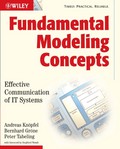Fundamental Modeling Concepts
Effective Communication of IT Systems

1. Edition March 2006
352 Pages, Softcover
Wiley & Sons Ltd
To develop information processing systems requires effective and efficient communication between many people. In order to understand requirements and design decisions, there is a need for a common conceptual model of the system: one that represents the architecture of the system. Communication between experts from different domains requires a common terminology and notation that is easy to apply.
This is where Fundamental Modeling Concepts (FMC) steps in. Primarily FMC is a consistent and coherent way to think and talk about information processing systems. It enables people to communicate the concepts and structures of complex information systems in an efficient way.
FMC provides you with a powerful tool for the early stages of system analysis and design. It is independent of any application domain or platform technology. It can be applied to business systems, to embedded systems or interactive systems, to systems which are implemented by programming computer systems, to wiring hardware components, to organizing the workflow between humans or to combined solutions.
Starting from a simple example, you will become familiar with the different types of system structures and their graphical representation. The authors' unique approach presents mappings between conceptual and implementation models and provides you with guidelines for the identification of system structures.
Preface.
1 Introduction.
1.1 The need for communication.
1.2 The FMC Idea.
1.3 Outline of this book.
2 Compositional Structures.
2.1 An example: The travel agency.
2.2 Modeling the structure of a system.
2.3 Agents accessing storages.
2.4 Agents communicate via channels.
2.5 Summary.
2.6 Exercises.
3 Dynamic Structures.
3.1 Petrinets: Basic principles.
3.2 Conflicts and conditions.
3.3 Basic patterns.
3.4 Responsibilities and scope boundaries.
3.5 Summary.
3.6 Exercises.
4 Value Structures and Mind Maps.
4.1 Entity sets and relationships.
4.2 Cardinalities.
4.3 Predicates and roles.
4.4 Partitions.
4.5 Reification.
4.6 Summary.
4.7 Exercises.
5 FMC Basics: Summary.
6 Reinforcing the Concepts.
6.1 The meta model: A mind map to FMC.
6.2 Operational versus control state.
6.3 Block diagrams: Advanced concepts.
6.4 Petrinets: Advanced concepts.
6.5 Non-hierarchical transformations and semantic layers.
6.6 Exercises.
7 Towards Implementation Structures.
7.1 System structure versus software structure.
7.2 From Processor to processes.
7.3 Distribution, concurrency and synchronization.
7.4 From FMC to objects and classes.
7.5 Conceptual patterns versus software patterns.
8 Applying FMC in Your Daily Work.
8.1 Becoming comfortable with FMC.
8.2 Describing existing systems with FMC.
8.3 Using FMC in construction.
8.4 Using FMCdiagrams to support communication.
8.5 Guidelines for didactical modeling.
8.6 Cost and benefit of modeling.
9 Modeling and Visualization Guidelines.
9.1 Introduction.
9.2 Increasingt he reader's perception.
9.3 Increasing comprehension.
9.4 Secondary notation, patterns and pitfalls.
10 Relationship with Other Modeling Approaches.
10.1 Comparing FMC with Structured Analysis.
10.2 FMC and the Unified Modeling Language.
11 A System of Server Patterns 247
11.1 Applicationdomain.
11.2 A pattern language for request processing servers.
11.3 Example applications.
11.4 Conclusion and further research.
Epilogue.
A Solutions.
B Reference Sheets.
C Glossary.
References.
Index.
Dr. Bernhard Gröne worked at SAP for 5 years as system analyst and architect. Following that, he completed his PhD at the Hasso-Plattner-Institute at the University of Potsdam. His research topics are analyzing and modeling complex systems and patterns.
Dr. Peter Tabeling has several years of industrial and academic experience in the modeling of complex systems, among them SAP's R/3 system. He is currently Assistant Professor at the Hasso-Plattner-Institute at the University of Potsdam, where he researches and gives lectures on FMC and other topics.


